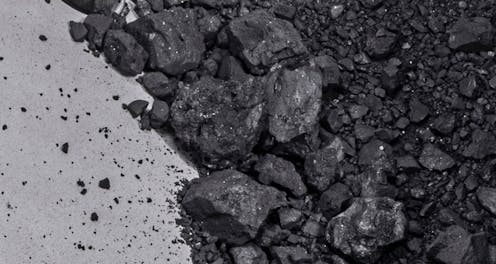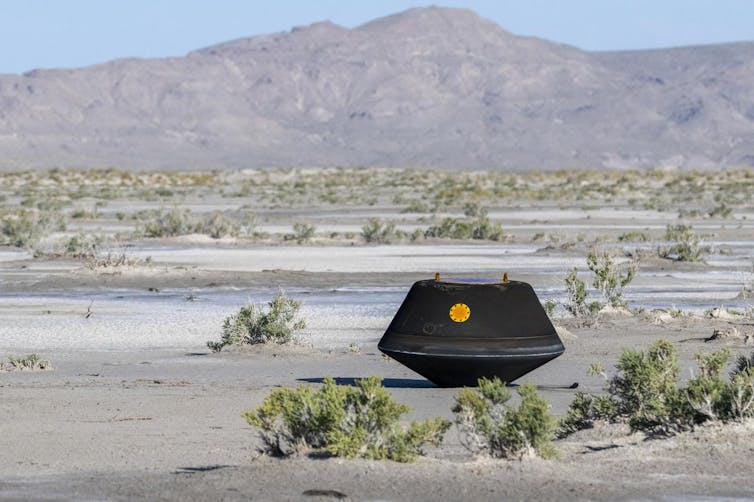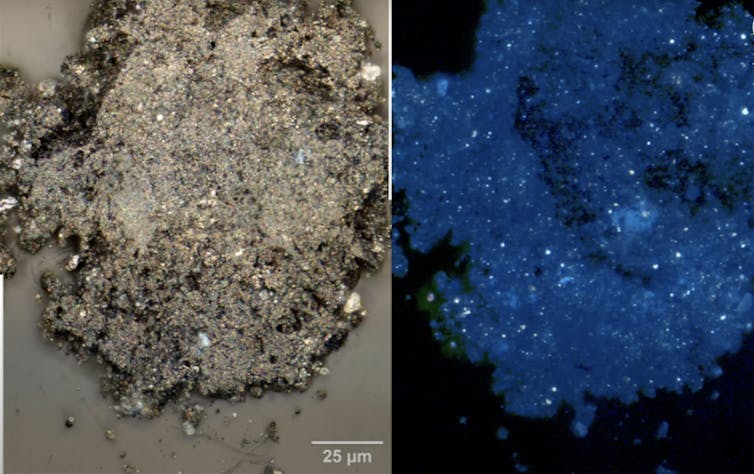
On September 24 this year, a Nasa capsule parachuted down to Earth carrying a precious cache of material grabbed from an asteroid. The space agency has now revealed images and a preliminary analysis of the space rocks it found after lifting the lid off that capsule.
The mission to the asteroid was called Osiris-Rex, and in 2020, it collected a sample of material from the asteroid Bennu. Afterwards, it travelled back to Earth and released the capsule containing the rocks into our atmosphere three weeks ago.
The fine black dust and small coal-like rocks shimmering in the capsule are beautiful – and somewhat unassuming. But this handful of space rock has the potential to answer questions about not only how the Earth was created, but also how water arrived here and how life got started.
At the Nasa press conference on October 11 held to reveal details about the sample, Dr Francis McCubbin hinted that, with careful storage and preparation, the material could be analysed and used in experiments for years to come.
“Scientists that aren’t even born yet, (will be able to) answer questions about the Universe using technology that has not even been invented,” said the astromaterials curator at Nasa’s Johnson Space Center, Houston, where the Bennu sample is being stored.
Why collect asteroid samples?
Sometimes material from space comes to Earth without our help, arriving as meteorites. Nasa has hundreds of meteorite samples in its collection, which are believed to have come from asteroids. Useful analysis can be carried out on these samples.
However, it’s often not possible to track down which asteroids these meteorites came from. This limits the potential of the resulting science. Meteorites are also contaminated by their journey through the atmosphere and onto the Earth. The Osiris-Rex sample, in contrast, is “pristine”. We can be sure any discoveries made from this sample tell us about Bennu.
Some of the finer dust in the Bennu sample would never have been able to form a meteorite and fall to Earth. Going and retrieving it is the only way we would ever have seen this type of material.

This is not the first asteroid sample delivered to Earth. Two Japanese space agency (Jaxa) missions, Hayabusa 1 and 2, made deliveries of asteroid material in 2010 and 2020. However, this is the first US mission to do so. It also returned with significantly more material than the Hayabusa missions.
Osiris-Rex delivered an estimated 250g of space rock, compared to Hayabusa 2’s 5g. This means the sample can be distributed to scientists around the world and put on display in museums for the public to enjoy. It also means that some larger rock fragments were included, which gives a unique opportunity to examine how different minerals are arranged in bigger chunks of the asteroid. This unlocks even more scientific potential.
What have they found?
Bennu is what is known as a “carbonaceous”, or C-Type, asteroid. These contain a large proportion of carbon and “volatiles” – compounds that can be readily vaporised, like water. These asteroids are believed to be relics from the formation of the Solar System, and so can help explain how the planets, including Earth, came to be.
Analysis of the main portion of the sample has taken longer than expected to get started, but it’s a nice problem to have. The sample collection technique was so successful that the sample was “spilling out” of the container within the return capsule. Because every grain is precious, all of this bonus material must be meticulously collected before the sample canister itself can be opened and preparation of the main body of the sample can begin.

Still, there have already been some exciting results from the initial analysis. Water has been found locked inside clay minerals from Bennu, which is an incredibly important discovery. One proposed mechanism for how water came to be on Earth and the other inner planets is that water was trapped inside clay minerals like these, which then formed rocks. These were eventually incorporated into planets during the birth of the solar system.
There’s abundant carbon in the sample – nearly 5% by weight – and sulphur. Both elements are essential for life. Carbon is the key ingredient in the organic compounds that make biology possible. Sulphur is an important component of amino acids, which form proteins.
Asteroids like Bennu are thought to have “seeded” Earth with prebiotic compounds: the building blocks of life. Magnetite (an iron oxide) found in the sample has been linked to chemical reactions crucial for the evolution of life. As Dr Daniel Glavin, Osiris-Rex sample analyst, summarised: “We picked the right asteroid. And not only that, we brought back the right sample.”
What next?
As well as helping answer the big questions of how we and our planet came to be here, finding water on asteroids is also destined to be a part of our future. Water can be broken down into hydrogen and oxygen, which can then be used as rocket fuel. While still some way off, spaceship refuelling stations are moving out of the realms of science fiction and into reality.
There’s only so much fuel you can take with you on a rocket. Far better to take just what you need to get off the planet and then fuel up in space for the rest of your journey.
Water can also be used for life support in future bases on the Moon and Mars. So it’s crucial to understand where we can access water in space, and how to extract it. The water on asteroids is one potential source.
Asteroids, once known best for their likely part in the demise of dinosaurs, are enjoying some positive time in the spotlight, showcasing their part in humanity’s past, present and future.
Lucinda King does not work for, consult, own shares in or receive funding from any company or organisation that would benefit from this article, and has disclosed no relevant affiliations beyond their academic appointment.
This article was originally published on The Conversation. Read the original article.







